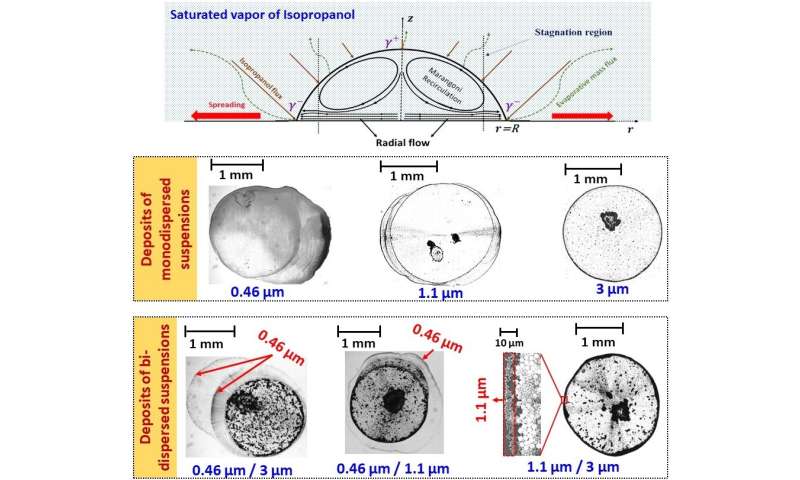Saturated alcohol vapor mediated colloidal deposits of an evaporating droplet on a surface

Understanding the deposition of micro- or nano-particles is central to designing innovative bioassays, biosensors, functional surfaces and ink-jet printing. An evaporating droplet containing colloidal particles results in a ring-like deposit of colloidal particles after the evaporation, as reported in a seminal work by Deegan et al in 1997. This is also known as the "coffee-ring effect" (CRE) in the literature. We extend the much-studied CRE and study the evaporation of a droplet on a surface containing colloidal particles in a saturated environment of alcohol vapor.
Interplay of coupled physics
While the CRE is much studied in the literature, the influence of saturated alcohol vapor on the evaporation of a droplet containing colloidal particles has not been much explored. In this configuration, the alcohol vapor molecules adsorb at the liquid-vapor interface non-uniformly, which creates a surface tension gradient along the interface, resulting in solutal Marangoni flow recirculation and spontaneous droplet spreading. The interplay between these two phenomena results in a complex internal fluid flow within the droplet.
Engineering colloidal deposits
We leverage the coupled physics described above to engineer the colloidal deposits. Compared to a ring-like pattern seen in the CRE, we report ring deposits with a larger diameter due to enhanced spreading and central particle deposits due to Marangoni recirculation, depending on the particle size. We also record different responses of the colloidal particles of different sizes to the above-described complex internal fluid flow, leading to strongly particle-size–dependent deposit patterns. While the smaller particles form a multiple ring pattern, larger particles form a single ring, and additional central deposits emerge.
Sorting of particles of different diameters
The interplay of enhanced droplet spreading and Marangoni recirculation allows us to sort colloidal particles deposited on a surface after the evaporation of the droplet. Different internal flow patterns corresponding to different sized particles and the spreading induced sharp wedge-like shape of the interface at the contact line enable us to achieve an efficient sorting of the smaller particles at the outermost edge of the deposits.
In closure, the present research provides fundamental insights and open up new avenues of designing colloidal deposits on a surface via evaporating droplets
This story is part of Science X Dialog, where researchers can report findings from their published research articles. Visit this page for information about ScienceX Dialog and how to participate.
More information:
Sanghamitro Chatterjee et al, Size-Dependent Dried Colloidal Deposit and Particle Sorting via Saturated Alcohol Vapor-Mediated Sessile Droplet Spreading, Langmuir (2022). DOI: 10.1021/acs.langmuir.2c00492
Sanghamitro Chatterjee is a Postdoctoral fellow at at Mechanical Engineering Department, I.I.T. Bombay, Mumbai, India. Janani S. Murallidharan is an Assistant Professor and Rajneesh Bhardwaj is a Professor in the same department.
Laboratory website: sites.google.com/view/interfaces-fsi-lab/home